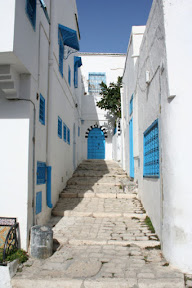Tripatini
the world's smartest travel social network
Untroubling Tunisia: Waiting for Travel and Democracy
 |
| From NMT Images |
Untroubling Tunisia: Waiting for Travel and Democracy
The thirty or so countries that make up the Arab world are not known for enlightened or progressive leadership.
But it was not always so.
In the Middle Ages when Europe was groping its way through the darkness in abysmal societies. Southern Spain, Andalusia, was a beacon to the world.
Here, from 711 to 1492, under Moorish/Muslim rule, Andalusia (from the Arabic Al Andalus) dazzled with art, science, architecture and religious tolerance.
From the magnificent Alhambra to the thoughts and writings of philosophers and scientists Averroes and Maimonides, Al Andalus paved the way for the Rennaisance.
Centuries later, Tunisia, under president Habib Bourguiba, created a progressive government, especially addressing issues affecting women’s rights, that was unique to North Africa and to the Arab world.
But the recent expulsion of Tunisian strong-man, President Zine Ben Ali, after 23 years in power, for corruption and cronyism, has made this beautiful and vivid country unsafe to visit and deeply troubled.
We hope only for a short time.
M and G News dubs the uprising, the “Jasmine Revolution,” and sees it as the birth pangs of an emerging liberal, democratic society.
Maybe.
But for those for whom Tunisia is just “one of those African or Arab countries,” they should know that this country is a study in vivid contrasts and juxtapositions – of conservative Islamic traditions and liberal European ones.
Hard-scrabble cities and rough, dusty towns that give way suddenly to flashes of beauty.
Streets clogged with cars and sheep and surreal traffic jams suddenly turn into winding souks jammed with sellers of everything – candy, pots, plates, leather goods, gold, silver, brushes, beads, coral, fezzes, and whatever.
And just when your senses balk with the overload, and you’re hopelessly lost, you’ll stumble into a cool, silent walkway and pass under an ancient archway that opens to the sparkling sea, fringed by green-clad mountains.
Wedged between troubled Algeria to its west and Libya to the east and forever married to the Mediterranean, this is not much of a place for the “average” tourists.
Not a lot of English is spoken – Arabic and French are the two chief languages. However the clever and witty Tunisians will quickly size up the visitor and seduce him or her into conversation (and thence into a shop) in German, Italian, Spanish and even some Croatian...and a smattering of English.
Big-eyed little kids with sunny faces sitting next to their pet sheep will be quietly watching from a doorway – watching you with curiosity and hoping for a “Bon Jour” or “Marhaba” (hello) so they can begin a friendship and a conversation in whatever languages you can all manage.
Luckily, one of Tunisia’s “must sees” is a fifteen-minute and a ten dollar ride from the Tunis-Carthage airport.
Sidi Bou Said, enjoys a perfect location for first time visitors. From there, it’s long walk or short taxi ride to Carthage – and a twenty-minute taxi or tram ride to the capital, Tunis.
Sidi is all winding, cobbled alleyways, colored-tiled archways and blue, blue doors. The town can be walked in fifteen minutes and really consists of a cafe-studded center and some artfully arranged shops.
Surprisingly active during the day and early evening with locals and tourists and buying and selling, it becomes sedate and very still at night, a night that belongs mostly to the cats and a few wandering friends and lovers.
It’s a perfect way to begin and end a trip.
A “must see” is the Ennejma Ezzahra, an ornate palace that houses the Center for Arab and Mediterranean Music, a treasure of musical instruments collected in the last seventy or so years.
The impressive collection is almost incidental to the beauty of the palace, which is actually a very big, bright white stucco house perched on a hill with sweeping views of the Mediterranean.
Carthage,the center of recent gun battles, is no stranger to unrest and war.
In reality little remains of the incredible Carthage that waged and lost the two Punic wars to Rome in 264-241 and 218-202.
Remember Latin class?
You’ll have to walk a lot to see the various sites, and it’s possible to buy a multiple entry ticket to the museum and the other places of interest for about $7.00 US.
Still, the imaginative traveler can visualize how once upon a time ago, these quiet and calm waters housed some 200 warships, the basis of her extraordinary power and wealth.
Tunisia will soon again be ready for travelers.
Tripatini Tip
 |
| From NMT Images |
Tunis, the capital. has a world-class museum in the Bardo.
Located a few miles from the city center, a cheap dollar taxi ride, or a quick tram ride to station
There are well-displayed Islamic treasures like early Quranic texts, Iznik jewelry, costumes and weapons.
You’ll be fatigued before you’ve seen the whole thing, so don’t try.
A couple of hours will be enough.
Videos
Groups
-
Catalonia, Its Culture &…
33 members
-
Barcelona
77 members
-
India
173 members
-
Tour Operators
873 members
-
Ireland
93 members
-
South Dakota
17 members
-
Azerbaijan
17 members
-
Shopping the World
55 members
-
Tech for Travel/Hospital…
87 members
-
Andorra
26 members
-
Online Corner
75 members
-
Minnesota
22 members
-
Backpackers & Hostels
84 members
-
Portugal
60 members
-
Turks and Caicos
26 members
© 2025 Created by EnLinea Media.
Powered by
![]()
Badges | Report an Issue | Privacy Policy | Terms of Service
You need to be a member of Tripatini to add comments!
Join Tripatini